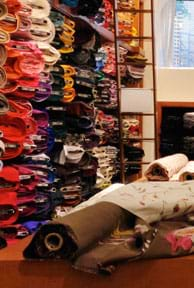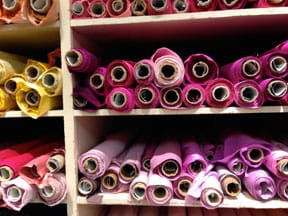Quick Look
Grade Level: 7 (7-8)
Time Required: 1 hours 30 minutes
(can be split into two 45-minute sessions)
Expendable Cost/Group: US $5.00
Group Size: 3
Activity Dependency: None
Subject Areas: Science and Technology
Summary
Students come to understand the basics of engineering associated with the use, selection, and properties of fabrics. A wide variety of natural and synthetic fibers are used in our clothing, home furnishings and in our travel and sports equipment. The specific material chosen for each application depends on how closely the properties of the material match the design needs. This activity focuses on the different characteristics of fabrics and shows students how natural and synthetic fabrics differ from one another. Students weigh the advantages and disadvantages of fabrics when considering the appropriate fabric to be used.
Engineering Connection
As part of their designs, engineers and material scientists consider the type of material that will be used. They look at all aspects of the problem and choose materials that best meet the needs and wants of the client and/or application. Besides clothing, fabrics are designed for and used in furniture, medical devices, speakers, agriculture and an uncountable number of engineered products.
Learning Objectives
After this activity, students should be able to:
- Use engineering terms involving decisions related to advantages and disadvantages of process and products.
- Analyze a product to determine the need it was designed to meet and the customer(s) it was mean to attract.
- Invent a product to meet a need.
- Use science, math and engineering principles to design and optimize the product.
Educational Standards
Each TeachEngineering lesson or activity is correlated to one or more K-12 science,
technology, engineering or math (STEM) educational standards.
All 100,000+ K-12 STEM standards covered in TeachEngineering are collected, maintained and packaged by the Achievement Standards Network (ASN),
a project of D2L (www.achievementstandards.org).
In the ASN, standards are hierarchically structured: first by source; e.g., by state; within source by type; e.g., science or mathematics;
within type by subtype, then by grade, etc.
Each TeachEngineering lesson or activity is correlated to one or more K-12 science, technology, engineering or math (STEM) educational standards.
All 100,000+ K-12 STEM standards covered in TeachEngineering are collected, maintained and packaged by the Achievement Standards Network (ASN), a project of D2L (www.achievementstandards.org).
In the ASN, standards are hierarchically structured: first by source; e.g., by state; within source by type; e.g., science or mathematics; within type by subtype, then by grade, etc.
NGSS: Next Generation Science Standards - Science
-
Conduct an investigation to produce data to serve as the basis for evidence that meet the goals of an investigation.
(Grades 6 - 8)
More Details
Do you agree with this alignment?
International Technology and Engineering Educators Association - Technology
-
Students will develop an understanding of the role of troubleshooting, research and development, invention and innovation, and experimentation in problem solving.
(Grades
K -
12)
More Details
Do you agree with this alignment?
State Standards
Massachusetts - Science
-
Given a design task, identify appropriate materials (e.g., wood, paper, plastic, aggregates, ceramics, metals, solvents, adhesives) based on specific properties and characteristics (e.g., strength, hardness, and flexibility).
(Grades
6 -
8)
More Details
Do you agree with this alignment?
-
Identify appropriate materials, tools, and machines needed to construct a prototype of a given engineering design.
(Grades
6 -
8)
More Details
Do you agree with this alignment?
Materials List
Each group needs:
- one 8" x 6" sample of six types of fabrics. Provide the following natural fabrics to test: cotton, linen, silk. Provide the following synthetic fabrics: polyester, nylon, rayon. Use a permanent marker to write the fabric name on each sample.
- balance, either a beam balance or an electronic balance accurate to 0.01g.
- watch with a second hand
- 250ml beaker
- ½ teaspoon
- scissors
- paper towels
- Worksheet A: Lab Instruction Sheet
- Worksheet B: Strength Test Diagram
- Worksheet C: Characteristics of Fabrics
Worksheets and Attachments
Visit [www.teachengineering.org/activities/view/focus_on_fabrics] to print or download.Introduction/Motivation
Your Engineering Challenge: The Department of Agriculture is trying to prevent the over- or under-seeding of crops. They are looking for engineering designs to ensure proper seed spacing. One option uses fabrics that have seeds embedded in them. Each fabric has different characteristics. To make sure that the best fabric is used for an application, the characteristics of the fabrics must be studied.
Today, you will perform tests on samples of synthetic and natural fabrics, analyze the test results, and use the information you gather to decide which fabric would be appropriate for specific applications.
Procedure
Background

The fibers used in textiles for apparel and home furnishings come from two major sources: natural fibers and synthetic fibers. The natural fibers that come from plants, such as cotton and linen, are generally comfortable and absorbent. Animal fibers, such as wool, silk and mohair, feel soft and luxurious. Spinning the clean original material produces natural fibers.
Synthetic fibers are created through a process that results in a usable fiber. Rayon is made up of regenerated cellulose materials (such as wood pulp and cotton waste). Even though the cellulose material is natural, it is processed with chemicals to create a thick synthetic liquid that can then be spun into a fiber. Other types of synthetic fibers are made from chemicals and are not naturally occurring. Examples include acrylic, nylon, polyester and spandex. These materials are generally easy to care for and resistant to oils and chemicals. Cellulose-based fibers, including acetate and rayon, usually require dry-cleaning.
While we have evidence that some natural fibers were used as long ago as 3,000 to 5,000 BC, synthetic fibers are relatively new inventions. Rayon, the first synthetic fiber, was commercially produced in 1910. Polyester, which is now the most commonly used synthetic fiber in the U.S., was first produced in 1953. New synthetic materials continue to be developed to meet the commercial, industrial and environmental needs of society.
With the Students
Part 1: Testing Synthetic and Natural Fibers
- Divide the class into groups of 2, 3 or 4 students each, depending on materials availability. Have students brainstorm a list of fabric types.
- Give each group the following: Worksheet A: Lab Instruction Sheet and the lab materials identified on Worksheet A and Worksheet B: Strength Test Diagram.
- Have each group perform the three tests on the fabric samples that are described on Worksheet A. The strength test must be done first. The permeability and absorbency tests are then done on the divided fabric samples.
- After the groups have completed the tests, come to a consensus as a class about the results.
- Pass out the attached Worksheet C: Characteristics of Fabrics. Have students add the results of their tests to the characteristics already listed.
- Lead a discussion on the ways that natural fibers differ from synthetic ones. Ask students whether they think rayon is natural or synthetic. This leads to a discussion of the differences between synthetic fibers from chemicals versus those regenerated from cellulose.
Part 2: Choosing a Fabric for an Application
- Propose the following design challenge: The Department of Agriculture has proposed that fabrics with seeds embedded in them be used to ensure proper seed spacing. Other advantages of this method include no seed loss to birds, a reduction in soil loss, and reducing weeds in the crops.
- Based on their research, have students recommend which material the seeded fabric should be made from. Groups should be prepared to discuss their choices, backing up their decisions with information about the characteristics of the fibers.
- Conclude with a class discussion about how students approached the problem like engineers.
Vocabulary/Definitions
cellulose: Long chains of glucose that make up the cell walls of plants.
nylon: Material based on synthetic resin.
polyester: Synthetic material formed from plastic.
rayon: Synthetic material based on regenerated cellulose. (Sometimes considered a semi-synthetic because it is neither a truly synthetic fiber nor a natural fiber.)
regenerated: Chemical process that turns natural cellulose into a liquid that is then re-treated and extruded as a fiber.
synthetic fiber: An artificial fiber produced by combining chemicals or altering natural fibers.
Assessment
Pre-Activity Assessment: Observe participation in brainstorming of fabrics.
Activity Embedded Assessment: Observe student participation within groups.
Post-Activity Assessment: Have students write-up descriptions of the fabrics they chose for seeding and explain why they chose them.
Investigating Questions
- Along with justifying the best design, did students consider the impact to the environment? What does it take to create the fabric? Is the fabric you selected biodegradable?
- What other characteristics of fibers would be valuable to investigate? (Some other characteristics are abrasion resistance, stain resistance, biodegradability, and shape retention.)
- T-shirts are often made of a 50/50 blend of polyester and cotton. What advantage exist with a blend rather than a 100% cotton shirt? (Two advantages are that adding polyester makes the material less absorbent and more resistant to shrinkage. What would be best for use as a table napkin or a bathroom towel?)
- Why do the prices of fabrics vary so much? Fabric prices vary because they depend on availability of the raw materials, manufacturing costs, and supply and demand pressures.
Activity Extensions
Have students research the uses and characteristics of some other synthetic fabrics, including polyolefin, acetate and spandex.
Have students research the different chemical compositions of synthetic materials.
React hexa-methylendiamine with adipoyl chloride to form nylon.
Do an interdisciplinary lesson with humanities exploring the history of natural and synthetic fibers.
Subscribe
Get the inside scoop on all things TeachEngineering such as new site features, curriculum updates, video releases, and more by signing up for our newsletter!References
http://www.fabrics.net/
http://www.fabriclink.com/
Microsoft Encarta 98 Encyclopedia CD. Fiber, polyester, nylon.
Copyright
© 2013 by Regents of the University of Colorado; original © 2001 WEPAN/Worcester Polytechnic InstituteContributors
Martha CyrSupporting Program
Making the Connection, Women in Engineering Programs and Advocates Network (WEPAN)Acknowledgements
Funded by Lucent Technologies Foundation.
Last modified: March 28, 2023






User Comments & Tips